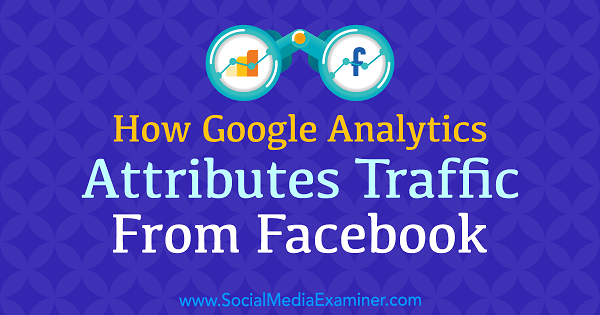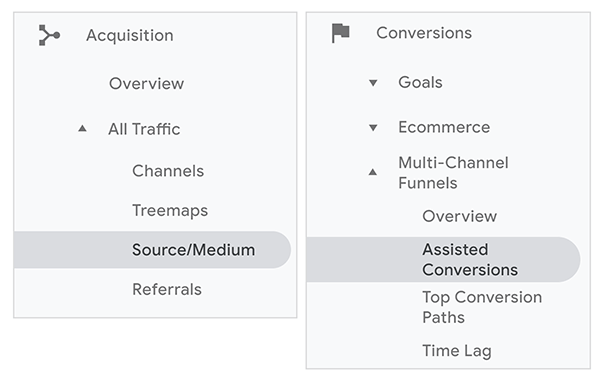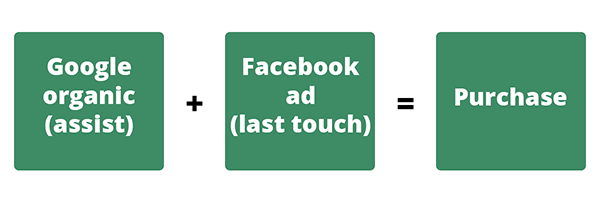|
http://bit.ly/2W9g4Sm
How Google Analytics Attributes Traffic From Facebook http://bit.ly/2Mq2fdK
In this article, you’ll learn how Google tracks traffic and conversions and how to resolve discrepancies between Google Analytics and Facebook Ads Manager. What Is Traffic and Conversion Attribution?To understand what attribution is and how it works, think about asking a friend for a restaurant recommendation. They tell you about a restaurant. Then you visit and enjoy your meal. Your friend’s recommendation resulted in a transaction, which is the meal you bought. If the restaurant owner wanted to give credit to someone for the transaction, they’d attribute it to your friend. In online measurement marketing, Google Analytics is the tool most people use to attribute which ads, posts, emails, and so on led to a sale. Say you do a search for a Google Home Mini personal assistant and buy it. Google Analytics sees your transaction and notes that the last thing you did before buying was a search, so the purchase is attributed to Google organic search. Although this basic definition of attribution seems simple, in reality, attribution often isn’t so straightforward. First, many social media marketers run Facebook ads, and if you check your conversion analytics in Facebook as well as Google Analytics, the attribution numbers often don’t match. Also, attributing a sale to a single source often doesn’t tell the whole story. In marketing, several ads or touchpoints often move customers toward a sale. #1: View Marketing Touchpoints in Your Funnel With Google AnalyticsGoogle Analytics can show you all sorts of data. The Source/Medium report focuses on the last action (also known as last touch) someone took before making the conversion (such as a purchase). The Assisted Conversions report shows additional actions that led to the conversion (also called assists).
To have an accurate understanding of your analytics and which traffic sources are working for your business, it’s helpful to understand the difference between last touch and assists, and how the reports show data differently. Remember that Google Analytics reports show the same data but differ in the way the data is calculated. Last Touch and the Source/Medium ReportLast touch matters in marketing analytics because it’s the last traffic source a customer interacts with before deciding to make a transaction. In the earlier online example, Google organic search was the last touch before the conversion occurred. In Google Analytics, a conversion can also refer to the completion of a goal, such as a click or an email signup. To see which traffic sources help you achieve conversions in Google Analytics, you look at your Source/Medium report. In broad terms, if you set up goals and tag your traffic correctly, this report lists all your traffic sources, and the Conversions section shows how many times each source led to someone completing your goal. To open the Source/Medium report in Google Analytics, click the Acquisition option under the Reports menu in the left panel. Next, select All Traffic and then Source/Medium. In this example, the Users column in the Acquisition section shows that Google organic search brought in 450 users. On the far right, in the Conversions column, 84 users who converted came from Google organic.
This report shows valuable data, but you also need to know what the report is showing and how the data is calculated. By default, the Acquisition Source/Medium report always references the last touch a customer made. To see assists, you need to look at a different report. Assists and the Assisted Conversions ReportTo understand assisted conversions, think again of the restaurant example. You ask a friend for a restaurant recommendation and they give you one. Later, you ask another friend for a recommendation, and they end up referring you to the same restaurant. After getting a second opinion, you finally go to the restaurant and enjoy your meal. In this case, your friends (both touches in this example) made a recommendation for the same restaurant that eventually led to a sale. Now you’ve got an attribution problem. What caused you to go to that restaurant? Which friend actually caused the sale? To understand how multiple touches are calculated in Google Analytics, return to the example of buying a Google Home Mini. You do a Google organic search or click a Google ad to find it but don’t buy it. Later, you click a Facebook ad and buy the product. Google Analytics will determine the Google organic search assisted in the conversion and Facebook was the last touch.
In other words, Google Analytics separates these attributions into two types: last touch attributions and assisted attributions. This way, the different roles that Google organic search and Facebook played leading up to the transaction are recorded. The illustration also works in reverse. You click a Facebook ad for the Google Home Mini but don’t make an actual transaction until you do a Google search on the product and read reviews. Google Analytics will record that the Facebook ad assisted in the transaction, and Google organic search would get credit as the last touch before the conversion.
Experience 3 days with the best social marketers. Discover the latest tactics and improve your marketing know-how! To see assists and last touches in Google Analytics, look in the Assisted Conversions report, which is the only place in Google Analytics that compares these two figures. You find this report in the Conversions section on the left panel under Multi-Channel Funnels. After you open the report, select Source/Medium as the report’s primary dimension, which breaks down assists and last touch conversions by traffic source. In this sample report, the Assisted Conversions column shows Google organic traffic assisted in 57 conversions. The Last Click or Direct Conversions column shows Google organic was the last touch for 59 conversions.
To compare the performance of Google organic search to Facebook’s pay channel (Facebook Cost Per Click), look at the Facebook CPC entry in the Assisted Conversions column. Facebook CPC assisted in 19 conversions. According to the Last Click or Direct Conversions column, Facebook CPC was the last touch before the conversion for 70 transactions.
#2: Understand the Gaps in Facebook Ads Manager Conversion ReportsNow that you know how Google Analytics calculates the data, you need to understand how Facebook Ads Manager tracks the same data. Facebook Ads Manager is where people typically go to figure out how their Facebook ads are converting. Staying with the earlier example, say you click a Facebook ad for a Google Home Mini and make a purchase. Facebook Ads Manager will record Facebook as the last touch. It calculates the data in the same way Google Analytics does. With filters in Facebook Ads Manager, you see attribution results for specific time intervals and click actions, although at a high level, the calculation is the same. However, when a customer has multiple touchpoints before they buy a product, Facebook Ads Manager and Google Analytics don’t track the same data. This difference leads to the discrepancies you see between Google Analytics and Facebook Ads Manager, and impacts how you evaluate the efficiency of your traffic sources. To illustrate, if a customer clicks a product’s Facebook ad but doesn’t make a purchase until they complete a Google organic search, Google Analytics can show you that the Facebook traffic source assisted in the sale and Google organic was the last touch. But the Facebook Ads Manager platform can’t see the assist part of a transaction because it has no visibility into other platforms.
#3: Analyze the Differences Between Google Analytics and Facebook Ads Manager ReportsDifferent Google Analytics reports and Facebook Ads Manager reports calculate marketing touchpoints in their own ways, so they never agree. Each platform defines conversions from its perspective, which comes from the available information. Some Google Analytics reports don’t show you assist data, and Facebook Ads Manager limitations always cause discrepancies in your analytics.
You can also take your analysis a step further by comparing the Facebook data in the Assisted Conversions report to the conversions reported in Facebook Ads Manager. When you see the data side-by-side, you can compare Facebook conversions in the two reports and start to add things together for a clearer picture of the impact your traffic sources have on sales. Say your Assisted Conversions report says Facebook assisted in 20 conversions and was the last click in 80 conversions. You can compare that to a Facebook Ads Manager report that might say Facebook led to 105 conversions for the same goal. You still have discrepancies, but they aren’t as big as the ones you see if you’re using the Acquisition Source/Medium report, which shows only last touch. ConclusionThe Facebook Ads Manager platform works differently than Google Analytics and doesn’t see the bigger picture due to its inability to access data. When you know how the data is calculated on different reports, the discrepancies you see start to make more sense. With more accurate insights into your data, you can use it to make informed decisions about your marketing. Remember to set up Google Analytics to track your traffic sources accurately. Then, you can use the Assisted Conversions report and Facebook Ads Manager to determine which traffic sources are working well for you, forecast your results, and optimize your marketing efforts. What do you think? Do you use any of these reports to analyze your traffic sources? How might you use them differently to improve your social media marketing? Please share your thoughts in the comments below. More articles about Google Analytics:There are 17 tracks of content available to you at Social Media Marketing World. Don't miss this event! Social Media via Social Media Marketing | Social Media Examiner http://bit.ly/1LtH18p January 23, 2019 at 05:01AM
0 Comments
Leave a Reply. |
�
Amazing WeightLossCategories
All
Archives
November 2020
|










 Because Google Analytics reports and Facebook Ads Manager attribute the transactions differently, you have to look at the report that will give you the most accurate data. When you’re comparing the performance of all of your traffic sources, these differences mean that the Assisted Conversions report in Google Analytics is the only way to see multi-channel conversion data.
Because Google Analytics reports and Facebook Ads Manager attribute the transactions differently, you have to look at the report that will give you the most accurate data. When you’re comparing the performance of all of your traffic sources, these differences mean that the Assisted Conversions report in Google Analytics is the only way to see multi-channel conversion data.
 RSS Feed
RSS Feed
